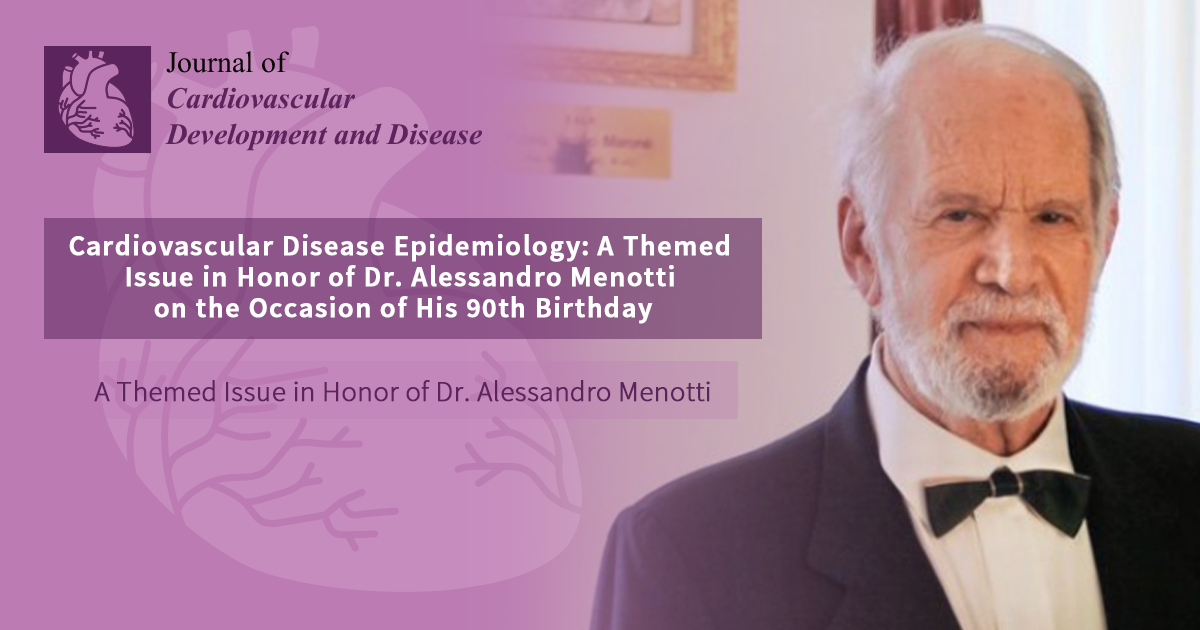Cardiovascular Disease Epidemiology: A Themed Issue in Honor of Dr. Alessandro Menotti on the Occasion of His 90th Birthday
A special issue of Journal of Cardiovascular Development and Disease (ISSN 2308-3425). This special issue belongs to the section "Epidemiology, Lifestyle, and Cardiovascular Health".
Deadline for manuscript submissions: closed (15 March 2024) | Viewed by 7508

Special Issue Editors
Interests: CV epidemiology; risk factors; outcome; lifestyle and diet; sudden death; mortality prediction
Interests: hypertension; cardiovascular telemedicine; cardiovascular disease prevention; cardiovascular imaging
Special Issue Information
Dear Colleagues,
The aim of this special issue is to honor Professor Alessandro Menotti on the occasion of his 90th birthdate in 2024. He was the youngest among the first generation of researchers involved in the Seven Countries Study (SCS) under the leadership of late Professor Ancel Keys. After 60 years of continued efforts worldwide he was the eldest of the third generation of SCS researchers and a supervisor of the study along a constant event coder for this reputed international investigation that set the foundation of cardiovascular epidemiology of heart diseases.
Professor Menotti published about almost 400 articles in peer-review international journals and 2 books in English and was the founder of cardiovascular epidemiology in Italy as a discipline and as an autonomous scientific area. MD and General Pathology Boards, Sapienza, University of Rome, I. Cardiology Board, University of Turin, I. Post Doc Certificates in epidemiology and biostatistics, London School of Hygiene, UK. PhD in Health Statistics. He held the following positions: Assistant, Division of Medicine, Government Hospital of Tripoli, Lybia; Research Associate, Laboratory of Physiological Hygiene, University of Minnesota, Minneapolis, USA; Assistant, Center for Cardiovascular Diseases, St Camillo Hospital, Rome, I; Research Director for Chronic Disease and Director, Laboratory of Epidemiology, National Institute of Public Health, Rome, I; part-time professor, Division of Epidemiology, University of Minnesota, Minneapolis, USA; Scientific Director Association for Cardiac Research, Rome, I; Consultant to the National Institute of Public Health of the Netherlands, Bilthoven, NL.
We encourage all colleagues and friends, but also deeply involved Researchers worldwide who devoted interest in cardiovascular epidemiology and had the opportunity to read and appreciate his important contributions in the field to contribute original scientific contributions and review articles or focused points of view to be grouped and published, after formal review, to form this special issue.
Prof. Dr. Paolo Emilio Puddu
Dr. Stefano Carugo
Dr. Xavier Humbert
Guest Editors
Manuscript Submission Information
Manuscripts should be submitted online at www.mdpi.com by registering and logging in to this website. Once you are registered, click here to go to the submission form. Manuscripts can be submitted until the deadline. All submissions that pass pre-check are peer-reviewed. Accepted papers will be published continuously in the journal (as soon as accepted) and will be listed together on the special issue website. Research articles, review articles as well as short communications are invited. For planned papers, a title and short abstract (about 100 words) can be sent to the Editorial Office for announcement on this website.
Submitted manuscripts should not have been published previously, nor be under consideration for publication elsewhere (except conference proceedings papers). All manuscripts are thoroughly refereed through a single-blind peer-review process. A guide for authors and other relevant information for submission of manuscripts is available on the Instructions for Authors page. Journal of Cardiovascular Development and Disease is an international peer-reviewed open access monthly journal published by MDPI.
Please visit the Instructions for Authors page before submitting a manuscript. The Article Processing Charge (APC) for publication in this open access journal is 2700 CHF (Swiss Francs). Submitted papers should be well formatted and use good English. Authors may use MDPI's English editing service prior to publication or during author revisions.
Keywords
- coronary heart disease
- outcome
- mortality
- risk factors
- prediction
- models
- sudden death
- congestive heart failure
- heart disease of uncertain etiology
- electrocardiology
- R-wave amplitude
- arrhythmias
- high blood pressure
- cholesterol
- smoke
- physical fitness
Benefits of Publishing in a Special Issue
- Ease of navigation: Grouping papers by topic helps scholars navigate broad scope journals more efficiently.
- Greater discoverability: Special Issues support the reach and impact of scientific research. Articles in Special Issues are more discoverable and cited more frequently.
- Expansion of research network: Special Issues facilitate connections among authors, fostering scientific collaborations.
- External promotion: Articles in Special Issues are often promoted through the journal's social media, increasing their visibility.
- e-Book format: Special Issues with more than 10 articles can be published as dedicated e-books, ensuring wide and rapid dissemination.
Further information on MDPI's Special Issue polices can be found here.








